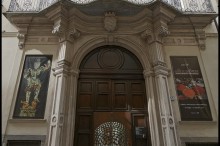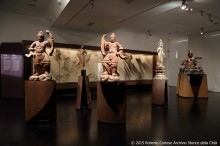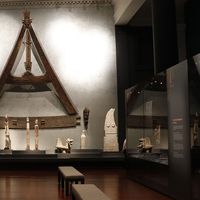Museum of Oriental Art, Italy

 The Museum of Oriental Art in Torino (abbreviated as MAO) is a recent reality among the few Italian institutions completely devoted to the artistic expressions of Asia. Inaugurated at the end of 2008 under the guidance of the Fondazione Torino Musei – a foundation devoted to the management of other important city museums – the MAO is rather peculiar when compared to similar institutions in Europe.
Turin boasts a rich tradition of Oriental Studies but could not rely upon great Asian art collections like those usually set up from the mid 19th to the mid 20th century and left by famous collectors to other cities.
The permanent collections of the MAO were founded upon a scattered legacy of works of art owned by the Turin Municipality and the Piedmont Region. The previous Oriental Section of the Civic Museum of Ancient Art, for example, had an important share of friezes retrieved during the 1950s from the region of Swāt in Gandhāra, as part of a project launched by the IsMEO (Italian Institute for the Middle and Far East) in Rome with the collaboration of the “Centro Scavi” (Excavation Centre) of the University of Turin. The Civic Museum also owned a series of Islamic potteries and a precious collection of Ottoman velvets.
The Piedmont Regional Government, on his part, had collected during the 1980s a relatively large series of thang-ka and wooden book covers from Tibet, as well as a number of Japanese woodcuts. Lastly, the Giovanni Agnelli Foundation had an important collection of ancient Chinese art put together mainly in the 1990s. Other miscellaneous objects, acquired or donated to the City of Turin in the course of the last century, have also found their way in the MAO collections.
The main aim of the local government in founding a new museum was to allow its citizens and foreign visitors to appreciate the artistic expression of distant cultures in the globalised world where we live.
The central core of objects explained above was thus significantly enlarged in the 2000s when the City of Turin and the Piedmont Region, backed by the Compagnia di Sanpaolo Foundation, started a huge campaign of new acquisitions on the international art market. All these new objects have been bestowed to the MAO, and an important contribution has also been made by long-term loans from banking foundations and private collectors. The policy of drawing attention to these subjects has the advantage of enriching the exhibit and bringing to light often important works of art otherwise inaccessible to the great public and unknown to scholars, that are now kept by the museum in order to be properly preserved, filed and studied.
The exhibit is housed in Palazzo Mazzonis, a noble building of the 17th-18th century located at the centre of Turin, and is divided into five cultural areas:
The Museum of Oriental Art in Torino (abbreviated as MAO) is a recent reality among the few Italian institutions completely devoted to the artistic expressions of Asia. Inaugurated at the end of 2008 under the guidance of the Fondazione Torino Musei – a foundation devoted to the management of other important city museums – the MAO is rather peculiar when compared to similar institutions in Europe.
Turin boasts a rich tradition of Oriental Studies but could not rely upon great Asian art collections like those usually set up from the mid 19th to the mid 20th century and left by famous collectors to other cities.
The permanent collections of the MAO were founded upon a scattered legacy of works of art owned by the Turin Municipality and the Piedmont Region. The previous Oriental Section of the Civic Museum of Ancient Art, for example, had an important share of friezes retrieved during the 1950s from the region of Swāt in Gandhāra, as part of a project launched by the IsMEO (Italian Institute for the Middle and Far East) in Rome with the collaboration of the “Centro Scavi” (Excavation Centre) of the University of Turin. The Civic Museum also owned a series of Islamic potteries and a precious collection of Ottoman velvets.
The Piedmont Regional Government, on his part, had collected during the 1980s a relatively large series of thang-ka and wooden book covers from Tibet, as well as a number of Japanese woodcuts. Lastly, the Giovanni Agnelli Foundation had an important collection of ancient Chinese art put together mainly in the 1990s. Other miscellaneous objects, acquired or donated to the City of Turin in the course of the last century, have also found their way in the MAO collections.
The main aim of the local government in founding a new museum was to allow its citizens and foreign visitors to appreciate the artistic expression of distant cultures in the globalised world where we live.
The central core of objects explained above was thus significantly enlarged in the 2000s when the City of Turin and the Piedmont Region, backed by the Compagnia di Sanpaolo Foundation, started a huge campaign of new acquisitions on the international art market. All these new objects have been bestowed to the MAO, and an important contribution has also been made by long-term loans from banking foundations and private collectors. The policy of drawing attention to these subjects has the advantage of enriching the exhibit and bringing to light often important works of art otherwise inaccessible to the great public and unknown to scholars, that are now kept by the museum in order to be properly preserved, filed and studied.
The exhibit is housed in Palazzo Mazzonis, a noble building of the 17th-18th century located at the centre of Turin, and is divided into five cultural areas:
- South Asia and South-East Asia in the eastern wing on the first floor, focused on the religious art of India;
- China in the northern wing on the first floor, consisting of very ancient funerary objects;
- Japan, with objects both of religious and secular nature, which occupies the western wing between the first and second floors;
- the Himalayan region on the third floor, centred on the Buddhist art of Tibet, Bhutan, and Nepal;
- and finally, on the fourth floor, art of the Islamic countries from over a wide area from the Mediterranean to Central Asia.
- China, mainly Neolithic to 10th century CE (36%): terracotta figurines, pottery, bronzes, wooden artefacts.
- Japan, 11th to early 20th century CE (30%): wooden sculpture, paintings, prints, lacquers, armours, textiles.
- South Asia & South-East Asia, mainly 1st to 19th century CE (14%): stone, bronze, stucco, and wooden sculpture.
- Islamic countries, 8th to 18th century CE (11%): pottery, bronzes, textiles, manuscripts.
- Himalayan region, mainly 13th to 19th century CE (9%): wooden and bronze sculpture, paintings, books and book covers, ritual objects.
View all Asia-Europe Museum Network (ASEMUS) members in Italy
Similar content
posted on
25 Mar 2012
22 Nov 2014
04 Dec 2014
posted on
29 May 2013
deadline
31 Jan 2020

